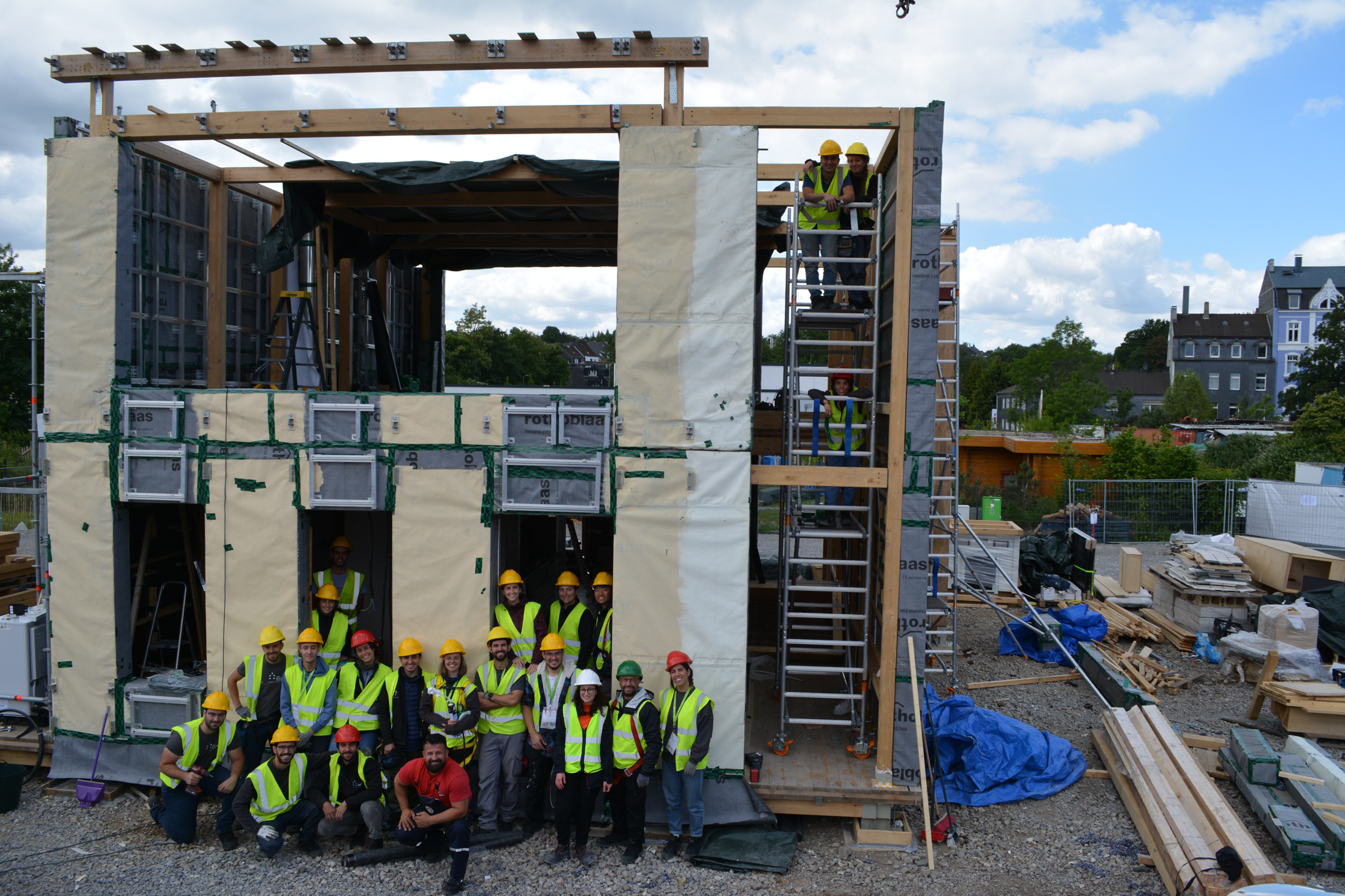Solar Decathlon Competition and LCA | Secondment with UPV
Posted on 27-10-2022
Leading up to the summer I completed my first secondment of three months at the Universitat Politènica de València (UPV), which was conveniently only a three-hour journey south along the Spanish coast from my host institution in Barcelona.
Life in Valencia involved drinking copious amounts of horchata (a local drink made from tiger nuts called Xufa) and enjoying Jardin del Turia, a park that was once a river which today hosts attractions such as gardens, sports facilities, and futuristic cultural buildings designed by architect Santiago Calatrava. I had the pleasure of working with my co-supervisor Ignacio Guillén and Life Cycle Assessment (LCA) expert Alberto Quintana Gallardo, Ph. D. in the department of Applied Physics. Together they provided excellent support with my plans to investigate housing projects from this year’s Solar Decathlon competition and to learn and apply LCA to built case studies during my stay.
As my project investigates Design for Disassembly (DfD) – in addition to Industrialised Construction – the Solar Decathlon competition was an exciting and unique opportunity to observe the disassembly and reassembly of sustainable homes, including the Spanish entry from team Azalea at UPV. As a former practicing architect where I worked with sustainability consultants who normally carry out LCA’s, I was also very eager to learn how to actually do an LCA myself.
Solar Decathlon
So what is the Solar Decathlon competition? It is an international competition where teams from universities build prototype homes known as ‘House Demonstration Units’ (HDU) that showcase the best in innovation and energy efficiency using renewable energy. Although the design aspect of the competition focusses on minimising operational carbon, the build challenge requires teams to first construct their HDU at a site in their home country, disassemble it, then transport and reassemble it in only two weeks at the competition site, also known as the Solar Campus. This means designing for disassembly is integral to the competition, making it a fantastic opportunity to study how housing can be more resource efficient over the building life cycle and understand practical building issues.
The competition and reassembly of the houses took place this year in May at the Solar Campus in Wuppertal, Germany. The 16 teams that made it to the build phase heralded from the Netherlands, France, Sweden, Romania, Czech Republic, Turkey, Taiwan, Germany itself, and of course Spain.
I seized the opportunity to observe and ask questions about the disassembly process, the reassembly process, and carry out interviews with each of the Solar Decathlon teams. When I arrived at UPV at the start of May, Team Azalea from UPV had finished building their HDU called the Escalà project on campus and had just held their inauguration event. Over the first two weeks of my secondment, I visited the house every day whilst it was slowly disappearing as it was taken apart and loaded onto five trucks headed to Germany, where the team would shortly reassemble it all over again! During this time, I got to know the team members who had bonded immensely during the intense competition period until this point. Before heading to Wuppertal myself, I was able to pilot interview questions covering technical and environmental sustainably aspects of the project with the Azalea team, as well as remotely with the SUM team from TU Delft.
The energy at the Solar Campus in Wuppertal was palpable as the teams were busy reassembling their HDU’s, each had an internal floor area of around 70m2 to give an idea of scale. I quickly got to know each of the projects and schedule interviews with the 16 teams, who kindly volunteered their time during the middle of the hectic reassembly period before the houses were judged and opened to the public. I managed to interview 13 teams on-site (the remaining teams were later interviewed online), including participants from different fields and both students and professors. Each team had a unique solution to the brief which called for either vertical and horizontal extensions or in-fill proposals. It was not only insightful but a pleasure speaking with true pioneering experts in housing designed for disassembly. Now’s time to complete the analysis of all that data!
Check out my Instagram highlights of SDE-22 for some on-the-ground footage.
LCA
Life Cycle Assessment (LCA) is an increasingly popular methodology and decision-supporting tool used by industry professionals and scholars to measure and compare the environmental impacts of buildings (European Commission, 2010). An LCA can be used to calculate Whole Life Carbon (WLC), which includes both embodied carbon from all the materials, processes, and transport to construct buildings and the operational carbon produced whilst a building is inhabited. WLC assessments are crucial to set environmental targets to decarbonise our building stock. There is currently a big knowledge gap around LCA amongst architectural practitioners and other stakeholders involved in the delivery of housing, partly due to the time-consuming nature of LCA’s. An LCA can be calculated simply with an excel spreadsheet or using various online platforms and plug-ins such as OneClick LCA, but amongst scholars more heavy software is called for, such as SimaPro – which is was what I would be learning to use whilst at UPV. My aim here was to carry out cradle-to-cradle LCA’s of case studies to quantify the benefits of DfD and the consideration of different lifespans for different parts of the building.
Work began on the first case study of a house designed and delivered by my co-supervisor Ignacio Guillén called Edificación Eco-Eficiente, or ‘EEE’, this was awarded a Class A energy rating and was the first single-family home in Spain to achieve the maximum VERDE* rating of 5 leaves. EEE was built using Industrialised Construction and prefabricated 2D elements that were assembled on-site in only 19 days. I was also able to visit the house on the UPV campus, though due to security reasons it can’t be used as a living-lab, which is a shame as it could provide some great in-use data on energy efficiency!
Using Simapro was (and still is) a steep learning curve with an incredible amount of precise and technical information that needs to be included. Imagine having to enter every single built element manually into a software, and not just modelled 3D objects but also coatings such as the surface area of zinc needed to galvanise steel, the grouting between tiles… the list goes on. Needless to say, LCA is an invaluable tool and will contribute greatly to my doctoral research project.
¡Hasta pronto!
I will be seeing my colleagues in Valencia again next month for the VIBRArch conference held by UPV to present my ongoing work on LCA. My secondment was invaluable in learning new skills and creating connections, particularly through the Solar Decathlon competition that I am continuing to follow up. Thank you to everyone at UPV, the Azalea team, and Solar Decathlon participants who provided such positive experiences and research opportunities!
*VERDE is a sustainability certification developed by Green Building Council Spain
Bibliography
Solar Decathlon Europe Competition website and knowledge platform with previous year’s entries
https://sde21.eu/sde21
https://building-competition.org/
Team Azalea’s Instagram page and website
https://www.instagram.com/azaleaupv/?hl=en
https://www.azaleaupv.com/
London Energy Transformation Initative ‘LETI’ provide an excellent embodied carbon primer for further reading on Whole Life Carbon
https://www.leti.uk/_files/ugd/252d09_8ceffcbcafdb43cf8a19ab9af5073b92.pdf
References
European Commission. (2010). ILCD Handbook - General Guide for Life Cycle Assessment: Detailed Guidance (1st ed.). Publications Office of the European Union.
Author:
A.Davis
(ESR1)


